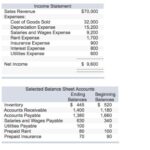-
HER FINNER DU OSS:
Bondistranda 29E, 1386 ASKER
HER FINNER DU OSS:
Bondistranda 29E, 1386 ASKER
23 Dec. 2022
The Best Startup Accounting Software

If you often work remotely and need a strong mobile app, consider Zoho Books. If you’re a service-based startup that intends to stay small, FreshBooks is worth looking startup bookkeeping at. If your company is in its organizational state and you’re looking to save money while also having access to unlimited users, Wave is a strong choice.
Fundamental accounting tasks
It’s not a rule, but it helps you measure and understand your company’s finances. Shopify Capital makes it easy to get funding quickly and use https://www.bookstime.com/articles/online-store-inventory-management-guide it for inventory, marketing, and more. If you’re ever in doubt about potential tax obligations, it’s wise to talk to a tax professional.
- Once you approve of the categories, transactions automatically settle in your financial statements.
- You can make journal entries, pay bills, schedule invoices, create financial statements, and so much more.
- You can set up basic small business accounting records in a spreadsheet, though this is more tedious, prone to manual errors, and time consuming than a comprehensive small-business accounting software.
- Recording entries and dividing them into accounts is only the starting point of the accounting process.
- Outsourcing mundane accounting tasks to professionals with expertise frees founders’ time for focusing on core objectives driving the business vision forward.
- As the owner, you’ll find that it’s easy to become wrapped up in the day-to-day tasks of running your business while ignoring that growing stack of papers on your desk.
Best for Very Small Businesses
You can set up basic small business accounting records in a spreadsheet, though this is more tedious, prone to manual errors, and time consuming than a comprehensive small-business accounting software. At the very least, you’ll want to track expenses and income in a secure cloud-based platform. Depending on the type of business transactions you’ll be making, different business credit cards have different perks. If you plan on spending a lot on travel, for example, a business credit card that offers miles may be ideal. Shopify Credit, for example, offers cash back on the category you spend on the most.
Accounting 101: A Guide for Small-Business Owners
The owner’s equity statement (also known as the statement of retained earnings) is a sum of the owner’s investments and withdrawals, as well as the business’s income and expenses. In double-entry bookkeeping, every transaction affects two accounts, meaning two entries are made. When a business keeps correct recordings of their transactions, the accounting equation always balances. Performing a cash flow forecast (where you estimate cash coming in and out based on previous performance) will help you anticipate and plan for any shortages and surpluses and adjust as needed.
Choose your accounting method (cash or accrual)
For example, you might decide to run ads geographically targeted to that area or open an office there for easier access to your prime demographic. Also, you could hire bookkeepers through agencies or work with a freelancer. It doesn’t matter which option you choose as long as the person is reliable, detail-oriented, a good communicator and comes recommended via professional or personal networks. Many software suppliers offer free trials which is a great way to test out the tools and see if they make sense for your needs.
Best small business accounting software of 2024 – TechRadar
Best small business accounting software of 2024.
Posted: Tue, 02 Apr 2024 07:00:00 GMT [source]
Startup business accounting can be particularly important since it’s likely that you’re operating your new business on a tight budget. But even if you’re lucky enough to have millions backing your business, your investors are going to want to know what you’re spending their money on. You can now customize your FreshBooks experience with a range of business-friendly apps. Take control of your startup accounting with the help of these integrations. The type of business entity you choose for your startup is hugely important. To learn more about business structures and determine the right one for your startup, check out our guide on How to Choose a Business Structure.
Accounting for Startups: What You Need to Know

Why the Ink Business Unlimited is essential for small business owners

- By: admin
- Comments: No Comments
16 Dec. 2022
5 best payroll systems for startups: Pros, cons, and features to look for
How your team uses an online payroll system will vary depending on the size of your team, the expertise of your employees and the system you use. Most services come with excellent sales and customer service reps who can help you get set up and answer questions you have along the way. Some payroll services are part of comprehensive HR platforms that include not only pay and benefits but also employee development, education and coaching programs. We found that while the majority of payroll services offer an employee portal, very few offer a well-rounded ledger report. Many providers rely on third-party integrations to handle this aspect of payroll, which we factored into our rankings.
If you want robust payroll insights and analytics, Paychex Flex may be the right choice for your business. This solution offers advanced reporting and analytics through customizable dashboards and real-time metrics on payroll costs, so you have a clear view of every dollar. Setting up payroll is one of the first steps when hiring and onboarding employees.
- Thousands of people have lost millions of dollars and their personal information to tax scams.
- And with its self-service portals, your employees can download pay stubs and tax forms.
- Fast employee turnover would be counterintuitive for startups aiming to hire the right people and foster a positive workplace culture.
- Xero, Twilio, Asana, Trello, and Google Sheets are examples of such applications.
- Automated tax filing and the option to pay employees via direct deposit both cost $15/month each.
Any business employing workers, whether full-time, part-time, or by contract, should consider using payroll software. After all, submitting payroll taxes is required, so make it easier on yourself with payroll software. Automating payroll can save you time, prevent human error, and ensure everyone gets paid the right amount and on time. Depending on the size of your business, you may want to have a dedicated person running your payroll software. All payroll software is made more helpful by accounting and time and attendance software integrations, and Rippling does that and much more.
Want More Helpful Articles About Running a Business?
With ADP, startup owners can automatically track and file taxes, create automated direct deposits, easily access state and federal forms and resources, and set up detailed, automated reporting. Best of all, all of these features are available in the base ADP plan, with even more useful features available in upper tiers. ADP is a payroll processing service that manages to pack a wealth of features into a platform that is surprisingly easy to use. This combination of being both easy to use and feature-rich is what earns ADP a spot on our list as one of the best payroll services for startups.
In fact, entrepreneurs allocate approximately 40% of their work hours to non-income-generating activities, including responsibilities like recruitment, HR tasks, and payroll management. Using research and writing skills from her academic background, Lauren prioritizes accuracy and delivering the best answer to the audience. She has over 13 years of writing and editing experience, including 2.5 years producing content about HR software and HR-related topics.
You can also establish employee or work policies such as leave, time off, vacations, and holidays. The digitization process aids in the improvement of precision and efficiency. Zenefits is designed to help SMBs with payroll software for startups payroll, benefits, and other employee-related tasks. It comes with tools for employee directory management, employee benefits, and insurance, recruitment and onboarding, ACA compliance, mobile support, and more.
Payroll for Startups: Top 8 Payroll Software for Entrepreneurs
Traditional companies offer customizable plans to fit your needs, while platforms tailored for startups offer straightforward pricing and all-inclusive packages you can get up and running in minutes. Workful is one of the newer online payroll services available, and it’s already making a name for itself with its top-notch customer support, which is why it’s our best customer service option. The geolocation time-clock tracking is easy enough to set up and ensures employees clock in and out from wherever you’ve set as appropriate.
What type of HR features should a payroll system have?
The easy-to-use cloud-based payroll software of KashFlow offers a comprehensive and streamlined approach to the entire payroll management. It can handle everything from workplace pensions to employee payslips in a matter of clicks, no matter where you are. Use the software to support both salaried and hourly employees, pay your contractors through Gusto, and let it file and automatically send the taxes.
Having a payroll system in place will make it easy to issue paychecks on time, avoid tax penalties, and keep your business finances in order. For most small business owners, the idea of running payroll themselves every pay period isn’t exactly exciting. That’s because running payroll can be a tedious and time-consuming process.
A payroll app needs to offer useful features for companies handling many different payroll situations. Some of the key ones we considered included offering tax modules and compliance features, along with analytics, new hire reporting, integrations with third-party providers and quality of the mobile app. Whether paying a housekeeper, landscaper or an actual nanny, you might be subject to the nanny tax. SurePayroll is one of the few payroll apps that specifically caters to nanny and household payroll. It includes deductions for Medicare, unemployment, state taxes and Social Security.
Because Rippling integrates with all employee management systems, manual tasks such as salary proration, 401k and tax deduction, and benefit allocation are automated. The system will automatically examine data, generate compliance inspections of your benefits, and send automated notices, while also ensuring employee privacy. Furthermore, Gusto consolidates all employee data, from emergency contacts to new hire documentation to anniversaries, allowing employees to access, amend, or download information as needed. This helps you to comply with HIPAA regulations while also making HR management more visible. Gusto is an online HR service solution for small businesses that’s designed to simplify complex business operations such as HR, benefits, and payroll.
Besides, you can also add a quick note to payslips if you need to. Run reports and review pay runs in a single click to get insights and the breakdown of all the amounts paid to each employee during a chosen pay period. The smart and easy-to-use payroll system of Gusto can be your next payroll software no matter what your business size is. Process payments manually or schedule them through Autopilot mode in a few clicks. That said, the payroll process is time-consuming and can be expensive. Besides, it may also involve human errors resulting in a huge business catastrophe due to payment inaccuracies, late tax submissions, and failure to comply with payroll tax laws.
How Ramp Procurement helped NPHY simplify, save time, and improve transparency
QuickBooks Payroll used to come as a mobile app, but discontinued it as of July 2022, moving everyone to its mobile responsive design instead. From startups to enterprises, the Zenefits payroll platform is designed to address every situation. Each plan includes advanced payroll features such as unlimited pay runs, garnishment support, direct deposits, contractor payments, general ledger reporting, dynamic mobile paystubs, and more. The platform integrates with a variety of business tools such as G Suite, Slack, Salesforce, and Xero. ADP is a global provider of HR and payroll services, offering a wide range of payroll capabilities for businesses of all sizes, including small businesses.
Also, employees can submit expenses through the app to get reimbursed with the next payroll run. Besides a fixed monthly cost, online payroll services often charge per transaction or employee payment. This implies that the larger the number of employees, the greater the transaction fee. If you are planning to expand your workforce, carefully consider how your payroll service cost will change while you are growing. Most payroll providers have a tiered payment structure to cater to businesses of different sizes.
Popular examples include Workday, Oracle Cloud, UKG and Ceridian Dayforce. If you have a dedicated person or team for processing payroll, you will likely be able to manage with a DIY payroll solution, which could be cheaper. Otherwise, you should consider https://adprun.net/ investing in an outsourced payroll service even if it is more expensive. This will help ensure that payments are processed accurately and on time. Deluxe offers services that fit businesses of any size, from entrepreneurs at launch to large enterprises.
- By: admin
- Comments: No Comments
29 Nov. 2022
Lease Accounting Guide: Roadmap for ASC 842 Deloitte US
The Supreme Court questioned these lines in the Act; “designed or adapted for living in” ruling that the buildings in the case were not a “house reasonably so-called”. Member firms of the KPMG network of independent firms are affiliated with KPMG International. No member firm has any authority to obligate or bind KPMG International or any other member firm vis-à-vis third parties, nor does KPMG International have any such authority to obligate or bind any member firm. Verify formulas/methodology before basing investment decisions on any model here. Paid contributors to the model receive a new download link via email each time the model is updated. A ‘Version’ tab is also included where you can view a change log for the model, as well as find important links related to the model.
For example, using Excel for tracking leases resulted in a $648,000 overpayment of rent for one customer before their LeaseQuery implementation. The inability to set up an alert to notify the accounting department when periodic rent should have been abated on every anniversary of the lease led to multiple years of steep unnecessary payments. Our Ultimate Lease Accounting Guide for ASC 842 contains 44 pages of examples, journal entries, disclosures, and more step-by-step guidance on operating leases and finance leases under the new standard.
- Keep in mind that Assets America can help finance the construction or renovation of commercial property through our network of private investors and banks.
- The annual operating lease expense is $20,000, or the straight-line treatment of 4 annual payments with no escalations, rent holidays, etc.
- Eisner Advisory Group LLC and its subsidiary entities are not licensed CPA firms.
- Certain services may not be available to attest clients under the rules and regulations of public accounting.
We can help finance the purchase, construction, or renovation of commercial property through our network of private investors and banks. For the best in commercial real estate financing, Assets America® is the smart choice. These are mortgages financing the lessee’s improvements to the ground lease property. Typically, lenders balk at lessor’s maintaining an unsubordinated position with respect to default. The lender controls insurance proceeds stemming from casualty and condemnation.
The new FASB and IFRS lease accounting standards (ASC 842 and IFRS 16) took effect in 2019 for public companies and will be effective in 2022 for private companies. The standards bring many leases onto the balance sheet and could significantly impact a business’ financial statements. Despite the Boards’ efforts to streamline lease accounting with the convergence of these new standards, some major differences between the two standards emerged.
The leaseholder will pay both an upfront payment to the freeholder and ground rent, which is usually paid monthly or annually. Ground leases are granted by the freeholder of land and buildings to a leaseholder, usually with a long lease. As with any other type of contract, there are benefits and drawbacks to signing a gross lease for both the landlord and the tenant. For example, since they are building on land they don’t own, tenants may need to get the approval of the landlord before construction can begin. And tenants can lose control of their building after the term of the lease expires. The principal payment is the difference between the actual lease payment and the interest expense.
Rights and Responsibilities
Another feature is for the lessor to assist the lessee in obtaining necessary licenses, permits and zoning variances. Another company lost a tenant improvement allowance worth over $2 million after they realized the TIA was not transferred appropriately during an acquisition. Reconcile the reference borrowing rate to the concluded incremental borrowing rate. For more information on this topic, please contact a member of Withum’s Real Estate Services Team.
But, if this fails then the court can mediate the process and ensure that a new lease is granted on fair terms. Because they are only purchasing a long lease, the upfront payment is considerably less than if they were to buy the freehold of the property. The advantage for the leaseholder is that they’ll be able to access a commercially viable asset that is often fully equipped, a ‘turn-key’ investment that they can immediately manage and make a profit on.
Under the new standards, tenants will record a right-of-use asset and a lease liability, initially measured at the present value of the lease payments, on their balance sheets. Tenants will then calculate interest on the lease liability and amortization of the right-of-use asset on their income statements to arrive at a straight-line lease expense. Among the many changes https://turbo-tax.org/ to lease accounting under this standard, the most significant is operating leases will be recorded on the balance sheet as lease assets and lease liabilities. The asset is known as the right-of-use asset, or ROU asset, and represents the lessee’s right to use the underlying asset while the lease liability represents the lessee’s financial obligation over the lease term.
Lease accounting hot topics for entities that have adopted ASC 842
If there is a preexisting mortgage, the mortgagee must agree to an SNDA agreement. Usually, the GL lender wants first priority regarding subtenant defaults. Paul Dolinshek is a Senior Manager in the Real Estate Services Group, with 10 years of public accounting experience serving the real estate and hospitality industry. Based on the company’s existing loan terms, the five-year rate of ABC Corp. will be used as the reference borrowing.
Featured Content
As we debit the lease liability account with the principal payment each year, its balance reduces until it reaches zero at the end of the lease term. Recall that under IFRS, lease classification has been abandoned as a practice. Otherwise, it is an ground lease accounting operating lease, which is similar to a landlord and renter contract. On a 30-year mortgage, that means a lease term of at least 35 to 40 years. However, fast food ground leases with shorter amortization periods might have a 20-year lease term.
In the UK, commercial ground rent will usually range between 5 and 10 percent of the income generated from the land and buildings for the leaseholder. The rent can be reviewed periodically, usually every 5 to 21 years. Increasing the rent in-line with CPI and RPI would be reasonable when the local market rental prices are increasing. Essentially then, commercial property ownership through leasehold involves both an upfront payment in-line with the property’s market value in combination with yearly or monthly ground rent.
What Happens When a Ground Lease Expires?
We came to terms with the Seller, entered into a purchase agreement and opened escrow. Additionally, we needed 80 percent financing on our multimillion-dollar purchase. So, Assets America handled both the sale and the loan for us and successfully closed our escrow within the time frame stated in the purchase agreement. In this day and age, it’s especially rare and wonderful to work with a person who actually does what he says he will do. We recommend them to anyone needing any type of commercial real estate transaction and we further highly recommend them for any type of commercial financing. They were diligent and forthright on both accounts and brought our deal to a successful closing.
Borrowers and lenders should begin conversations early to come to an agreement on how these metrics may impact their covenants. The motive here was to enable the leaseholders in properties approaching the end of their long lease to purchase that property as freehold rather than simply renewing the lease at considerable expense. This would unlock long-term homeowners in leasehold properties from ground rent, restricted covenants and other rules set by the freeholder.
- By: admin
- Comments: No Comments
23 Nov. 2022
What is a sole proprietorship?
The business owner, also known as a proprietor or a trader, conducts business using their legal name. They may also choose to do business using another name by registering a trade name with their local authority. A Sole proprietorship is a business, owned, controlled and managed by a single individual. A Sole Proprietor reaps the financial rewards and https://business-accounting.net/ is responsible for all risks and liabilities while conducting the business. It is suitable for individually managed occupations like salons or small retail shops. Overall, Schedule C is a relatively easy form to follow—broken up into five sections asking about your income, expenses, cost of goods sold, information on your vehicle, and other expenses.
- The business entails some liability risks, has the potential for large profits and a large customer base, and is positioned to benefit from certain tax structures.
- Making regular payments can help a proprietor keep their tax burden from becoming overwhelming and incurring tax penalties.
- For instance, a freelance graphic artist working from home technically owns a sole proprietorship.
- Many and varied private organizations and individuals seek opportunities to invest and fund a business that may not qualify for traditional financing from institutions, such as banks.
- To change your DBA name you would typically file for a “termination or abandonment” of DBA for the old name first.
- A sole proprietor can only obtain bank loans with short durations, his own savings, or donations from relatives and friends.
Compared to proprietorships, other business entities require a much longer and more complex legal document for incorporation. The paperwork required by the government before a sole proprietor can set up his business is easy and straightforward. Of all business structures, tax rates are considered the lowest under sole proprietorship, according to the Small Business Administration (SBA). A sole proprietor is someone who owns an unincorporated business by themselves. If you are the sole member of a domestic limited liability company (LLC) and elect to treat the LLC as a corporation, you are not a sole proprietor. Though the process varies depending on the jurisdiction, establishing a sole proprietorship is generally an easy and inexpensive process, unlike forming a partnership or a corporation[1].
Create a free account to unlock this Template
A sole proprietorship is the default business entity that your business falls into if you do nothing and are the only owner of your business. A sole proprietorship is a business entity where all liabilities and financial obligations pass to the single owner of the business. Those choosing a sole proprietorship are usually in low-liability career fields and seek the administrative ease and flexibility that comes with this type of entity. We’ve compiled a list of eight different types of businesses that make good sole proprietorship examples.
How to decide between a sole proprietorship vs. an LLC or corporation
If you’re on the fence between the two types of business formation check out the full Sole Proprietorship vs. LLC comparison. As a sole proprietor, you’ll report your business income and expenses on the Schedule C form of your personal income tax return. You’ll pay federal and state income tax on your business profits, and you’ll also pay self-employment taxes. A sole proprietorship’s profits are taxed as the owner’s personal income, and—despite its name—sole proprietorships may hire employees so long as they have an Employee Identification Number (EIN). This being said, in order to file your general income taxes for your sole proprietorship, you must complete the required forms on the same schedule as your personal tax returns. Therefore, you must file by April 15 unless you file an extension, which will give you until October 15 to file.
In fact, you should set aside a percentage of your business’s income to cover the sole proprietorship taxes due on the profit in your business. You should remember, however, that when you take money out of your business to pay your taxes, it will come out as an owner’s draw and not an expense. Some areas require all businesses to register their information with the city or county even if they are sole proprietorships, so be sure to understand your local laws. Additionally, you may be required to obtain a license to conduct certain types of business in your area. An individual considering starting a business may wonder how to start a sole proprietorship. Unlike limited liability companies or corporations, a sole proprietorship does not have to be registered with the state.
It can be difficult for individuals to manage all aspects of their business properly. The owner can hire employees, outside help, or get professional advice on parts of the business process. Making regular payments can help a proprietor keep their tax burden from becoming overwhelming and incurring tax penalties. Tax advisors can help proprietors estimate taxes so they can set aside enough of the profits to make mandatory government payments[2].
Bakery Owner
Ask a question about your financial situation providing as much detail as possible. Our writing and editorial staff are a team of experts holding advanced financial designations and have written for most major financial media publications. Our work has been directly cited by organizations including Entrepreneur, Business Insider, Investopedia, sole proprietorship meaning Forbes, CNBC, and many others. Our goal is to deliver the most understandable and comprehensive explanations of financial topics using simple writing complemented by helpful graphics and animation videos. We follow strict ethical journalism practices, which includes presenting unbiased information and citing reliable, attributed resources.
A sole proprietorship is the default choice for anyone who runs a business but hasn’t set up another formal business structure like an LLC. As a sole proprietor, there’s no separation between your personal and business assets and expenses. You are personally responsible for all your business’s debts and obligations.
Customer Suzy slips in the puddle and falls, striking her head on the arm of a chair. The Tea Shoppe will likely be responsible for paying Suzy’s medical bills, but if Suzy sues the business for negligence, she can also sue Amelia personally, or seek to collect her judgment from Amelia’s personal assets. As a sole proprietor, you should also get into the habit of setting aside money for income tax which would be paid to the Internal Revenue Service at the end of the year. If the sole proprietor is set in their ways, the business would be operated using methods that may not suit contemporary realities. Other forms of businesses encourage innovation because of shareholders’ different backgrounds and experiences. Corporate entities and business owners are generally not held liable for damages done by the company in a court of law.
Many and varied private organizations and individuals seek opportunities to invest and fund a business that may not qualify for traditional financing from institutions, such as banks. For the sole proprietor, seeking to take advantage of this facility, there are various factors that must be understood and adhered to regarding the loan application. Proprietors control all aspects of their business, including production, sales, finance, personnel, etc. This degree of freedom is attractive to many entrepreneurs, as the venture’s success also means personal success.
Proprietors must pay individual taxes on the income periodically, for example, as part of the annual individual tax filing. Tax payments may be more frequent, for example, quarterly, depending on local tax rules. For this reason, it is common among small businesses, freelancers, and other self-employed individuals. Ultimately, a sole proprietorship is best for you when you have an idea and want to start immediately.
The money spent on taxes goes toward government projects that help improve our country. The sole proprietor personally inspires and encourages staff to be aware of company goals and objectives, fostering organizational loyalty among them. Customers may be required to submit reports to a customer service department staffed by individuals who have never met the company’s owners or shareholders before, for example. If a sole proprietor is wronged by another party, he can bring a lawsuit in his own name. Conversely, if a corporation or LLC is wronged by another party, the entity must bring its claim under the name of the company.
- By: admin
- Comments: No Comments
15 Nov. 2022
Taxpayer identification numbers TIN Internal Revenue Service
The staff can help you complete an application and will submit it for processing. Applicants who meet one of the exceptions to the requirement to file a tax return (see the Instructions for Form W-7) must provide documentation to support the exception. Low Income Taxpayer Clinics (LITCs) are independent from the IRS and TAS. LITCs represent individuals whose income is below a certain level and who need to resolve tax problems with the IRS. LITCs can represent taxpayers in audits, appeals, and tax collection disputes before the IRS and in court. In addition, LITCs can provide information about taxpayer rights and responsibilities in different languages for individuals who speak English as a second language.
- Unlike other forms of ID, ITINs only have one purpose—tax filing and reporting.
- If the tax return you attach to Form W-7 is filed after the return’s due date, you may owe interest and/or penalties.
- All the exceptions are listed in the ITIN application instructions.
- Applicants who meet one of the exceptions to the requirement to file a tax return (see the Instructions for Form W-7) must provide documentation to support the exception.
- A list of these in-person Document Review Taxpayer Assistance Centers is available on IRS.gov.
IRS issues ITINs to help individuals comply with the U.S. tax laws, and to provide a means to efficiently process and account for tax returns and payments for those not eligible for Social Security numbers. They are issued regardless of immigration status, because both resident and nonresident aliens may have a U.S. filing or reporting requirement under the Internal Revenue Code. You can file Form W-7, Application for IRS Individual Taxpayer Identification Number (ITIN), with your federal income tax return.
How to file your federal tax return using an ITIN
Even if you have a PTIN but you received it prior to September 28, 2010, you must apply for a new or renewed PTIN by using the new system. If all your authentication information matches, you may be issued the same number. You must have a PTIN if you, for compensation, prepare all or substantially all of any federal tax return or claim for refund. An ITIN may be assigned to an alien dependent from Canada or Mexico if that dependent qualifies a taxpayer for a child or dependent care credit (claimed on Form 2441). The Form 2441 must be attached to Form W-7 along with the U.S. federal tax return. Both taxpayers and their dependents may qualify for an ITIN, allowing for individuals to report their income, claim dependents, claim tax credits, and refunds if they are eligible.
Government information
Proposed regulations permitting the IRS to shorten third-party notice requirements in certain circum… Acceptance Agents (AAs) and Certifying Acceptance Agents (CAAs) can help you complete applications. USA.gov is the new centralized place for finding government benefits for health care, housing, food, unemployment, and more. Official websites use .gov A .gov website belongs to an official government organization in the United States. For a summary of those rules, please see the new Form W-7 and its instructions.
More In Forms and Instructions
For more information or to find an LITC near you, see the LITC page on the TAS website or Publication 4134, Low Income Taxpayer Clinic List. The Taxpayer Advocate Service is an independent organization within the IRS that helps taxpayers and protects taxpayers’ rights. We can offer you help if your tax problem is causing a financial difficulty, you’ve tried and been unable to resolve your issue with the IRS, or you believe an IRS system, process, or procedure just isn’t working as it should. If you qualify for our assistance, which is always free, we will do everything possible to help you. The advantage to using CAAs is that for primary and secondary applicants (like a spouse), the CAA can certify that your documents are original and make copies to send to the IRS. That way, you won’t have to mail your originals or copies certified by the issuing agency.
Refunds
The Individual Tax Identification Number, or ITIN, allows taxpayers who don’t have a Social Security Number (SSN) to file income tax returns. Unlike other forms of ID, ITINs only have one purpose—tax filing and reporting. Having an ITIN number won’t make you eligible for benefits, such as Social Security or earned income credits that provide refunds to some low-income filers. When a significant natural disaster hits – such as a hurricane, earthquake, tornado, flood, wildfire, blizzard, or the like – the IRS will extend upcoming federal tax deadlines for affected taxpayers if a federal disaster is declared. The extended due dates apply to most federal tax returns and payments, including those for income taxes (including estimated tax payments), payroll taxes, and excise taxes. If you’re impacted by a natural disaster, check our IRS Disaster Relief page to see if you qualify for an automatic tax filing or payment extension.
All features, services, support, prices, offers, terms and conditions are subject to change without notice. United Ways of California what is the difference between operating and non improves the health, education and financial results for low-income children and families by enhancing and coordinating the advocacy and community impact work of California United Ways across the state. The taxpayer Bill of Rights is grouped into 10 easy to understand categories outlining the taxpayer rights and protections embedded in the tax code. For more information see Allowable Tax Benefits in the Instructions for Form W-7 PDF. A Taxpayer Identification Number (TIN) is an identification number used by the Internal Revenue Service (IRS) in the administration of tax laws.
An Individual Taxpayer Identification Number or ITIN is a tax processing number that the IRS issues to tax filers who are ineligible for a social security number. The ITIN is not valid for employment, but can be used to file your taxes, open a bank account, access credit and loans, and is a start to your financial footing in the United States. You can apply for an ITIN any time during the year when you have a filing or reporting requirement. At a minimum, you should complete Form W-7 when you are ready to file your federal income tax return by the return’s prescribed due date. If the tax return you attach to Form W-7 is filed after the return’s due date, you may owe interest and/or penalties. You will usually file an ITIN application, Form W-7, Application for IRS Individual Taxpayer Identification Number, with your first tax return, which you must file as a paper return, not electronically.
- By: admin
- Comments: No Comments
14 Nov. 2022
Compound Interest Calculator Daily, Monthly, Quarterly, or Annual

You may also wish to check out ourrange of other finance calculation tools. The compounding of interest grows your investment without any further deposits, although you may certainly choose to make more deposits digital contract signing over time – increasing efficacy of compound interest. See how your savings and investment account balances can grow with the magic of compound interest. The majority of credit cards compound daily, so it’s important to understand the principal and interest payment each month and have a plan to pay it off. To account for reinvestment, you can re-apply the formula above for each reinvestment period to adjust the principal between each period. $10,000 invested at a fixed 5% yearly interest rate, compounded yearly, will grow to $26,532.98 after 20 years.
Many banks compound interest daily, but some compound it weekly, monthly or even quarterly. The more frequently a bank compounds your interest, the faster your money will grow. But depending on your balance and interest rate, the difference between daily and monthly compounding might only be a matter of pennies. A savings account’s compound interest rate is typically expressed as an annual percentage yield (APY). Certificates of deposit (CDs), money market accounts, and savings accounts may pay compound interest on a daily or monthly basis. Although the interest rate may be less than other investments, this adds up over time.
Compound interest can also work against you when you have to pay it. So you may pay interest on your interest if you carry a balance from month to month. The compound interest rate lenders charge is usually expressed as an annual percentage rate (APR). Compound interest occurs when interest is added to the original deposit – or principal – which results in interest earning interest.
Besides savings accounts and CDs, several other financial products can earn compound interest, including bonds, money market accounts, high-yield savings accounts, dividend stocks and real estate investment trusts. Compound interest is a form of interest calculated using the principal amount of a deposit or loan plus previously employee furlough accrued interest. Unlike simple interest, which doesn’t apply to previously accrued interest, compound interest allows your money to grow exponentially over time.
- While only $0.53 in interest was gained by compounding daily, this is essentially free money that is earned because of more frequent compounding.
- Experiment with different variables to see how changes affect your potential earnings.
- Credit card companies and other lenders also use compound interest to calculate your debt.
- It’s important to remember that these example calculations assume a fixed percentage yearly interest rate.
- See how much daily interest/earnings you might receive on your investment over a fixed number of days, months and years.
Compound Interest Calculator (Daily To Yearly)

This means your investment grows faster compared to simple interest, where interest is calculated only on the principal amount. Understanding this concept is crucial for anyone looking to maximize their financial growth. With savings accounts, compound interest works by continually adding interest you earn to the funds you’ve deposited. Different banks add—or compound—interest at different rates, known as the compounding frequency.
Get 5 FREE Video Lessons With Uncommon Insights To Accelerate Your Financial Growth
Use the compound interest calculator below to determine how much interest you can earn in a savings account. In reality, investment returns will vary year to year and even day to day. In the short term, riskier investments such as stocks or stock mutual funds may lose value. But over a long time horizon, history shows that a diversified growth portfolio can return an average of 6% annually. Investment returns are typically shown at an annual rate of return. Making regular, additional deposits to your account has the potential to grow your balance much the direct write off method faster thanks to the power of compounding.
Downloadable Results: PDF and XLS Formats
It is for this reason that financial experts commonly suggest the risk management strategy of diversification. Calculate percentage additions and deductions with our handy calculator.
How do compounding intervals affect interest earned?
We’ve discussed what compound interest is and how it is calculated. So, let’s now break down interest compounding by year,using a more realistic example scenario. We’ll say you have $10,000 in a savings account earning 5% interest per year, withannual compounding. We’ll assume you intend to leave the investment untouched for 20 years. Now that you understand how powerful compound interest can be, let’s break down how it’s calculated.
While only $0.53 in interest was gained by compounding daily, this is essentially free money that is earned because of more frequent compounding. Also, as the principal value gets larger and the time horizon gets longer, this amount will start to add up. When interest compounding takes place, the effective annual rate becomes higher than the nominal annual interest rate. The more times theinterest is compounded within the year, the higher the effective annual interest rate will be. Understanding Compound Daily Interest is crucial for financial success. Our online calculator is your gateway to mastering this concept, offering precise calculations and downloadable results.
- By: admin
- Comments: No Comments
28 Oct. 2022
IOLTA Account Overview and Best Practices for Law Firms

While it may seem simple on paper, the reality is that maintaining a compliant and ethical IOLTA account can be incredibly complex and time-consuming, especially without the proper tech stack. The strict state-specific rules and accounting intricacies can be a malpractice trip wire for the most experienced lawyers. After all, even big law firms with dedicated accounting teams have specific processes to maintain IOLTA compliance.
7 Top Tax Deductions for Lawyers and Law Firms

When the Supreme Court and state legislatures created IOLTA in the 1980s, attorneys could deposit their earnings into an interest-bearing trust account. The banks would typically donate the interest to a program or charity controlled by the state bar. But they still fulfill their ethical and fiduciary obligations by safeguarding their clients’ money. So, the firm must keep accurate and detailed records of the money deposited and withdrawn from the account.

Best practices
- Software like MyCase’s legal accounting solution makes this easy by assigning trust account funds to specific clients.
- Track every deposit and withdrawal in separate client ledgers, recording transactions as they occur.
- When a lawyer obtains a large sum for a client, they usually deposit this money in a trust fund that accrues interest.
- Clients benefit from IOLTA as they gain peace of mind in knowing their funds are held in a secure place.
- Make sure you verify what rules apply to your law firm with your state bar association.
- Any assets transferred into the trust account belong to the client and must be managed on their behalf.
- If you require legal or professional advice, kindly contact an attorney or other suitable professional advisor.
All attorneys holding clients’ funds in an attorney trust account have a duty of recordkeeping. We are fiduciaries and the fiduciary legal standard puts the burden on the lawyer to prove that it was done right, not on the client to prove it was done wrong. Typically, trust funds are used for short-term deposits — things like money to be expended on attorney’s fees online bookkeeping or costs in a relatively short period of time, such as under six months.
IOLTA Account vs. Escrow Account

And remember, if you choose to have a third-party bookkeeper maintain your trust account, you are still responsible for the conduct of those people. Marc Garfinkle practices in Morristown, focusing exclusively on legal ethics, attorney discipline, bar admission and judicial conduct. He is also an adjunct professor at Seton Hall University School of Law in Newark.

Trust Accounting: Quick Guide for Law Firms
- Principal among them is the development of proposals to change legal practices that provide opportunities for dishonest practitioners to exploit the trust of clients.
- If you completed all services and paid all expenses, you will return the remaining unused $7,250 to the client.
- Before IOLTA came about in the early 1980s, trust accounts were to be put into non-interest-bearing checking accounts since lawyers were not to benefit from their clients’ money.
- For the sake of simplicity, some law firms report trust deposits as income in their legal accounting software.
- The interest generated typically depends on the type of account and the institution holding the funds.
- This is so even when the funds are earned and even if the engagement agreement provides for immediate withdrawal.
That “record” must include the “date, source and description” of every deposit and the “date, payee and purpose” of every withdrawal. Under normal IOLTA programs, no trust account will earn interest that can trust accounting for lawyers be divided and paid to the individual clients. Almost all lawyers in private practice are required to maintain a firm trust account under their state’s attorney trust account rules. The rules in various states might be written differently, but the concepts are the same. Clearly, trust accounts are very important to the lawyer, but it should be emphasized that these accounts are also very important, and desirable, to the bank where they are deposited. Client trust funds can offer a large and stable deposit for the bank, although this depends on the nature of the law practice.
After all, your clients could be paying you a big pile of cash as a retainer, and they would love to know what happens with their cash. While trust accounting seems like a relatively straightforward concept, keeping track of client trusts can get complicated if you’re managing accounts for multiple clients. The ABA requires firms to keep client funds separate from business funds. This distinction helps prevent law firms from accidentally misappropriating client funds for non-client expenses. Before opening a non-IOLTA trust account, check your local jurisdiction’s https://www.bookstime.com/ laws and the local Bar Association’s requirements to confirm this is allowed. Since you’re acting as a fiduciary on behalf of your client, you must also disclose information related to the non-IOLTA account to clients, like interest rates and fees.

Step 3: Use the Right Trust Accounting Software
Lawyers sleep soundly knowing they’re compliant and can confidently continue to help their clients. Explicitly, IOLTA applies only to funds that are “nominal in amount or held for a short period of time”. So larger amounts of money held for single clients are exempt from the IOLTA program.
- By: admin
- Comments: No Comments
06 Oct. 2022
How to Become a QuickBooks ProAdvisor: Elevate Your Skills With QuickBooks Desktop and Online

This step-by-step guide will provide you with the information you need to become a certified QuickBooks ProAdvisor. Let’s embark on this journey to unlock the full potential of QuickBooks expertise and pave the way for a successful and rewarding career in accounting and finance. Certified ProAdvisors can take the What’s New in QuickBooks Online training to prepare for the recertification exam.
Data Lake vs Data Warehouse: How to choose?

Advanced certifications are also available for people who wish to have a deeper understanding of QuickBooks. The advanced training sessions are led by Intuit QuickBooks specialists, after which you must pass an extra exam. Your advanced QuickBooks certified degree boosts your reputation, improves your familiarity with QuickBooks systems, and allows you to better serve your clients and expand your firm. Now, there are more ways to move up the tiers, and unlock new and better benefits. The program was recently updated to a points structure that recognizes more of the work you already do. If you are part of a team under the same QuickBooks Accountant firm all your points will be aggregated together to help you move up the tiers more quickly.
- The objective is to retain and rebuild our relationship with our accountants.
- The system saves where you end a session, which enables you to pick up where you left off later.
- You can earn up to 14.5 credits with the new self-paced training courses for QuickBooks Online ProAdvisor and Advanced QuickBooks Online ProAdvisor.
- Learn how to start a QuickBooks ProAdvisor certification course and become a certified ProAdvisor.
- The Personalized path is where you can personalize your training journey based on your goals, product knowledge, and more.
- Your Find-a-ProAdvisor profile will also be included in the results of search engine sites like Google and Bing.
- Throughout the year, we’ll launch new benefits and incentives, so that together, we can help power prosperity for our shared clients.
Tip #4. Utilize study guides and practice exams
The software provides an automatic sync of your clients’ transactions with QuickBooks Online or Desktop version reducing manual bookkeeping and accounting processes. You should be able to access your badge on the available certifications page within 60 minutes of passing your certification exam. For complete instructions, see Accessing your Certification History. There are selected countries for international versions who can take the ProAdvisor training.
- All five portions should take about three and a half hours to finish.
- But when I got to step 3, I don’t see the Accountants & Bookkeepers tab at the page.
- The path involves comprehensive training and passing a certification exam, which tests both your knowledge and practical application of the software.
- Hevo is fully automated and hence does not require you to code.
Trial Balance in QuickBooks® Online Accountant Reimagi…

QuickBooks is a bookkeeping software used by individuals and small business alike. We’re walking you through everything you need to know below, from prepping for the certification exam to passing the test with flying colors. If you’re ready to add “QuickBooks Certified” to pro advisor certification your resume, read on. I am certified in both the basic and advanced levels of QuickBooks Online.
- Learn about the changes and how to get more points in the new point activities.
- We help Small Business Owners find a qualified QuickBooks accounting professional.
- You’ll find courses for all of QuickBooks’ products here, as well as preparation materials for the certification examinations listed below.
- They’re independent accounting professionals and not employed by Intuit.
- Elite-level ProAdvisors get access to contests, promotions, discounts, and exclusive industry events.
- To keep your ProAdvisor status, you need to complete continuing education and regularly pass recertification exams.
Webinars, virtual conferences, and https://www.bookstime.com/ in-person events taught by Advanced QuickBooks Certified ProAdvisors. Master the latest QuickBooks tools so your clients always have an expert to turn to.

- The best aspect is that you can grow your business for free by devoting a few hours of your time to it.
- We encourage you to evaluate each QuickBooks Certified ProAdvisor thoroughly to ensure they are the right fit for your business.
- Practical experience with the software will help you understand its features and functionalities better, which is crucial for the exam.
- Get QuickBooks Online, QuickBooks Payroll, and QuickBooks Time for free—plus, a range of discounts on other software, services, and supplies.
- It isn’t a business degree and shouldn’t be confused with an accredited education.
Hevo is fully automated and hence does not require you to code. QuickBooks ProAdvisor Certification grants you access to outstanding marketing materials that can help you stand out from the competition, generate leads, and develop your brand. Certification badges demonstrate to prospects that you are a QuickBooks specialist, which increases your credibility. Its completely automated pipeline, fault-tolerant, and scalable architecture ensure that the data is handled in a secure, consistent manner with zero data loss and supports different forms of data. The solutions provided are consistent and work with different BI tools as well.

One response to “Redesigned U.S. ProAdvisor Program”
All of https://x.com/BooksTimeInc the training tools, including self-guided modules, webinars, and live course alternatives, are absolutely free to become a QuickBooks Online ProAdvisor. This program is designed for accounting professionals and is often free, especially for the online version. Joining the program gives you access to the training materials and certification exams. ProAdvisors are members of the QuickBooks ProAdvisor Program.
- By: admin
- Comments: No Comments
06 Oct. 2022
Nonprofit Accounting: A Complete Guide with Best Practices
Find out whether somebody is already providing the service you intend to offer. Do you have a clear plan that guides your strategic decisions and will bring in revenue? Being prepared and well covered is the only way to ensure that your organization will still be there next year or 10 years from now.
- Learn how to calculate your nonprofit’s public support in order to properly file your annual tax return.
- They’ll also be able to provide management and the board of directors with an ongoing and clear picture of the current financial health of the nonprofit.
- If you have a nonprofit organization, working toward making the world a better place is likely your top priority.
- A nonprofit organization must follow special accounting rules when recording in-kind donations.
- Whenever new tax laws pass, the rules outlining how nonprofits must handle and report income change.
In addition, to fund accounting, most nonprofits run multiple programs or projects in tandem. This means the nonprofit often will need to keep records – let’s call them “sub-ledgers” – in which they separately record the revenue and expense related to each program or project. Different projects often have different funders, which generally require reporting not only on the organization as a whole but also on the progress of their funded projects. Thus, ‘project accounting’ becomes a critical need of the organization for communication with grant-makers and donors. It also helps the organization to determine the financial status of any particular project and whether it is incurring expenses consistent with the revenue received or expected for that project. Here’ we’ll overview the financial reports all nonprofit organizations are required to create regularly, as well as some optional reports that may help you run your business more effectively.
Key Principles of Nonprofit Accounting
In the realm of nonprofit accounting, there are four key financial statements that organizations utilize to present their financial information. These statements are prepared in accordance with the Generally Accepted Accounting Principles (GAAP) and are governed by the Financial Accounting Standards Board (FASB). A statement of cash flows is a financial statement that provides information about a nonprofit organization’s cash receipts and payments. It helps to illustrate how cash flows in an organization and cash balance changes over time. Additionally, you’ll need financial statements to obtain and maintain funding, grants, and other forms of support. Accurate financial statements also ensure nonprofits manage charitable resources responsibly, ethically, and according to applicable laws.
- Because nonprofit accounting is all we do, there is zero guesswork on terminology, procedures, and nonprofit-specific reporting like fund accounting and functional expenses.
- An easy way to understand where there’s room for improvement is by integrating an analytical tool.
- Find out whether somebody is already providing the service you intend to offer.
- In turn, this helps encourage growth while developing new programs or deciding which ones to discontinue.
- Indeed, a nonprofit that engages in accounting best practices will have a better chance to weather any financial storms that may appear on the horizon.
To accomplish this, it is necessary to establish clear policies and procedures for accounting and finance, including how money is handled and who has access to financial records. While accounting software is not required for all nonprofits, it can be a valuable tool for organizations that have complex financial needs. Additionally, accounting funds can help nonprofit organizations track expenses and revenue sources. The statement of financial position provides a more traditional balance sheet format, while the statement of activities emphasizes changes in net assets over time.
Perhaps you started a nonprofit,
Obviously the big one is not having to pay tax on net income (subject to local laws). Learn about opportunities to raise money for your nonprofit business or improve the services you offer. You’ll probably have no products or services to sell, at least at the beginning. As the financial stewards of nonprofits, accountants play a vital role in ensuring the long-term sustainability of these organizations.
Plus, holding a virtual meeting may be more convenient if your staff has to travel or lives in different regions. These are online spaces where you can keep your community engaged, and where they can engage with each other and discuss topics related to your mission. Be sure to sign up for our 5-part email course, Nonprofit Financial Management Overview for Executive Directors and http://softnew.ru/katalog/igrovaya-atributika/by,category_name/dirDesc.html check out the free resources linked below. From there you can build on that base to improve performance and begin working strategically to make your dreams for your organization’s future a reality. Access Xero features for 30 days, then decide which plan best suits your business. It’s easy to forget to do this, but you may be liable for extra taxes if you don’t do it on time.
Managing Nonprofit Tax Obligations
Revisiting the above examples, you would book your electric expense to December in an accrual accounting system because that’s when you used the electricity (regardless of when you paid for it). In a cash accounting system, you record transactions only when cash changes hands. They include anything you pay for, from rent to payroll to purchasing supplies. Plus, non-cash outflows, like when you use or give away, resources you received as a donation.
- In addition, this code discusses the circumstances in which a nonprofit organization will be liable for taxes, penalties, and other charges.
- Some source interviews were conducted for a previous version of this article.
- Communicate internal policies and controls throughout the organization to reduce accounting mistakes and prevent employee accounting fraud.
- Common examples of in-kind donations include food, office supplies, and professional services.
- Budget vs. Actual is an internal report which displays your planned budget and your actual performance side-by-side.
As a nonprofit organization, you are required to follow certain accounting practices to maintain your tax-exempt status. Unlike for-profit businesses, nonprofits must comply with financial accounting standards set by the Financial Accounting Standards Board (FASB). Overall, accrual accounting is considers superior to cash basis accounting for nonprofit organizations. Nonprofit organizations are required to follow certain financial reporting requirements, which are designed to ensure that they are using their resources responsibly and transparently. However, by following a few simple steps, nonprofit organizations can ensure that their accounting is accurate and up-to-date. Read this article for more about tracking and allocating functional expenses for nonprofit organizations.
Accurate accounting also allows for budgets to be more precise when submitting grant applications to fund projects. Without accounting, an organization will struggle https://www.cool-savers.com/contact.php to maintain their operations and effectively expand. Functional expenses refer to the allocation of costs among different organizational activities.
An income statement for nonprofits is a financial statement that shows the sources and uses of funds over a set period of time. It typically details all revenue, such as contributions, grants, salaries, administrative costs, and program costs. Below, we go over all the https://rusimpex.ru/Content_e/TradeServices/sendinfo.php?parloc=main essentials, from setting up your books to preparing financial statements. With the information in this guide, you’ll be able to make informed decisions and confidently manage your nonprofit’s finances.
What are the key differences between for-profit and non-profit accounting?
Financial ratios help nonprofits measure the financial health of the organization. Aplos offers a full suite of tools for nonprofits looking to bring ease and flexibility to their accounting practices. Their online software includes detailed reporting, donor management tools, and built-in email marketing and communication. In the world of nonprofit work, the term “statement of financial position” is widely used to describe how an organization plans to use its money. The official financial position is similar to a balance sheet in that it provides visibility into what a group owes, owns, or has in cash reserves at any given moment. The crucial difference between nonprofit and for-profit accounting is their relationship to profit.
- By: admin
- Comments: No Comments
02 Sep. 2022
How to Determine the Cash Realizable Value in Accounting

Net Realizable Value NRV is a commonly used technique for valuing assets based on how much money it will generate upon its eventual sale. In short, it measures the liquid value of a receivable account or inventory.Net Realizable Calculations can help business owners determine how much new sales and revenue can be expected from their current assets. Regarding inventory management, your net realizable value determines the inventory’s liquidation value. When it comes to business longevity, consistent cash flow, effective inventory management, and proper financial planning are critical. There are many official regulations that businesses must adhere to when it comes to accounting reporting. This interacts with your net realizable value calculations, as you must make the most conservative estimates when calculating your asset values.
How does NVM interact with the GAAP?
Raw materials are stated at the lower of cost (first-in, first-out method) or net realizable value. The Company periodically reviews the value of items in inventory and records write-downs or write-offs based on its assessment of slow moving or obsolete inventory. The Company maintains a reserve for obsolete inventory and generally makes inventory value adjustments against the reserve. However, when we applied the LCNRV rule to each individual item, we found that we had to adjust some inventory downward, such as the Rel 5 HQ Speakers that are listed at FIFO at $110 each, but only have an NRV of $50 each.
Step 2: Estimate the Allowance for Doubtful Accounts

In practice, the NRV method is most common in inventory accounting, as well as for calculating the value of accounts receivable (A/R). For instance, if the debit balances in the account receivables are $10,000 and have a credit balance of $800, then $9,200 is the resulting value of accounts receivables in the net realizable value method. It is worth noting that the adjustments can be made for each item in inventory or for the aggregate of the entire net realizable value inventory to the lower cost or NRV. Once curtailed down, the inventory account becomes the new basis for reporting purposes and valuation.
- It usually requires certified public accountants (CPAs) to do the job as it involves a lot of judgment.
- However, in some instances where we have extensive inventory databases, this can become tedious and impractical.
- NRV helps business owners and accountants understand the true value of an asset.
- Loosely related to obsolescence, market demand refers to customer preferences, tastes, and other influencing factors.
- NRV is particularly important for valuing inventory and accounts receivable.
- Our AI-powered Anomaly Management Software helps accounting professionals identify and rectify potential ‘Errors and Omissions’ throughout the financial period so that teams can avoid the month-end rush.
What Is Invoice Cost?
- You can base this on past experience if you have an established business.
- Accounting standards (IRFS and US GAAP) require that we apply a conservatism principle when we assess the value of assets and transactions.
- Average net fixed assets refer to the mean value of a company’s net fixed assets over a period.
- While this could prompt changes within your billing processes, it also means that you can make more informed decisions on who to extend credit to moving forward or on how you’d like to manage your future receivables.
NRV is particularly important for valuing inventory and accounts receivable. By calculating NRV, businesses can avoid overestimating the value of their assets, which enhances financial reporting accuracy and supports better decision-making. Knowing your net realizable value is about more than being able to determine the expected selling price of an asset, product, or service. For example, you should also endevor to set up comprehensive payment terms, use automation, and conduct regular credit checks. Chaser can also be used to help you determine the best net realizable value method for your business. Net realizable value calculations are a simple yet incredibly effective way to determine your potential losses when selling inventory or offering credit to customers and clients.

Benefits of Calculating the Accounts Receivable NRV
- The market value of this inventory i2 is $200, and the preparation cost to sell this inventory i2 is $30.
- This ensures that your financial statements provide a true and fair view of your financial position.
- Alternatively, when the economy is down, clients may pass on orders or find it more difficult to make full payments.
- As technology evolves and production capabilities expand, unsold inventory items may quickly lose their luster and become obsolete.
- Therefore, the net realizable value (NRV) estimates the amount that a seller would expect to receive if the asset in question was sold, net of any selling or disposal costs.
- However, it is a recommended best practice to avoid overestimating the value of your receivables.
In either situation (high inflation or high unemployment), it may be more difficult for clients or businesses to find budget for additional goods to buy. As economies thrive, clients often have more money at their disposal and are able to pay higher prices. Alternatively, when the economy is down, clients may pass on orders or find it more difficult to make full payments. Assessing LCNRV by class also reduced ending inventory, which reduced gross profit and net income (third column).
Accumulated Depreciation
Suppose a manufacturing company has 10,000 units of inventory that it intends to sell. On the accounting ledger, an inventory impairment of $20.00 would then be recorded. A company XYZ Inc. is trying to get rid of some of its outdated phones, and it expects to sell them for $5,000 to a local buyer, but it must pay $240 to have them shipped and insured and another $40 to complete the paperwork.

The following formula is used to calculate the Net Realizable Value (NRV). Enter the Selling Price, Cost of Goods Sold, and Estimated Selling Expenses into the calculator to determine the Net Realizable Value. This calculator can also evaluate any of the variables given the others are known. It is essential to remember that we are performing our analysis as of 31 December 2020. Remember that while this is permitted under IFRS, US GAAP does not allow for write-down reversals if inventory value goes up subsequently.
Key components of NRV
Employing the NRV method is a way to evaluate inventory and accounts receivable while applying conservatism and following the accounting standards’ stipulations. NRV is a conservative method as it estimates the real value of an asset, net realizable value after deducting selling costs or costs of disposal. The first is the percentage of sales method, in which a percentage of credit sales is estimated to be uncollectible based on historical experience and current economic conditions.
HighRadius Autonomous Accounting Application consists of End-to-end Financial Close Automation, AI-powered Anomaly Detection and Account Reconciliation, and Connected Workspaces. Delivered as SaaS, our solutions seamlessly integrate bi-directionally with multiple systems including ERPs, HR, CRM, Payroll, and banks. The calculation for Net Realizable Value has a variety of methods to get an answer. No matter which method you use to find the NRV, the value you find must fit the conservative method of accounting reporting. In the following year, the market value of the green widget declines to $115.
- By: admin
- Comments: No Comments

